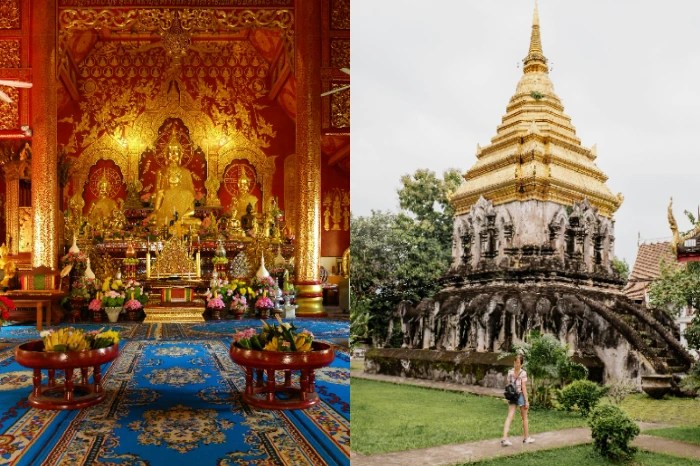Chiang Mai, the cultural capital of Northern Thailand, is a spiritual haven filled with centuries-old temples, or “wats,” reflecting both Theravāda Buddhist philosophy and the architectural grandeur of the Lanna Kingdom. For Indian travelers, Chiang Mai offers not just serenity and symbolism, but also cultural connections through Buddhism, shared values, and sacred relics. Here are the top 7 temples that deserve a place on every Indian traveler’s Chiang Mai itinerary.
Table of Contents
ToggleWat Phra That Doi Suthep
Perched high on Doi Suthep mountain, this 14th-century temple is Chiang Mai’s most iconic spiritual site. Legend says a sacred relic was placed on a white elephant that climbed the mountain, trumpeted, and passed away at the very spot where the temple now stands.
Why visit: Climb the 306-step Naga staircase to reach the gleaming golden stupa, explore intricate murals, and take in panoramic views of the city – especially magical at sunrise. It’s one of the holiest pilgrimage spots in Northern Thailand.
Wat Chedi Luang
Located in the heart of the Old City, this majestic ruin was built in the 14th century and once housed the sacred Emerald Buddha. Though partially collapsed due to an earthquake, the towering brick chedi still commands awe and respect.
Why visit: Experience the ancient Lanna architecture, see massive elephant carvings along the base, and participate in daily “monk chats” to better understand Buddhist philosophy and Thai monastic life.
Wat Phra Singh
A prime example of classic Lanna temple design, Wat Phra Singh dates back to 1345 and is home to the revered Phra Singh Buddha image, believed to have originated in Sri Lanka.
Why visit: Admire beautifully restored wooden structures, stunning gold detailing, and traditional murals. During Songkran (Thai New Year), witness vibrant rituals as locals ceremonially bathe the Buddha for blessings.
Wat Chiang Man
Chiang Mai’s oldest temple, built around 1296 by the city’s founder, King Mengrai. It houses some of the most important Buddha images in Chiang Mai, including a crystal Buddha and a marble one believed to possess protective powers.
Why visit: Discover peaceful grounds, the famous Elephant Chedi (supported by stone elephant statues), and unique Lanna architectural elements that give a glimpse into the city’s earliest spiritual roots.

Wat Umong
A 700-year-old forest monastery set in a tranquil wooded area near the base of Doi Suthep. Its ancient tunnels and Ashoka pillar replica reflect both meditative seclusion and Buddhist history.
Why visit: Wander through moss-covered tunnels, feed fish and turtles by the pond, and experience true spiritual solitude. It’s ideal for meditation or quiet reflection, far from the city’s bustle.
Wat Suan Dok
Built in the 14th century as a royal flower garden temple, Wat Suan Dok is now a peaceful complex with white chedis containing the ashes of Chiang Mai’s former royal family.
Why visit: Attend free evening meditation sessions, engage in “monk chats,” and marvel at the large open-air prayer hall. The temple’s westward orientation also offers stunning sunset views.

Wat Sri Suphan (Silver Temple)
Located in Chiang Mai’s traditional silversmith district, this one-of-a-kind temple is entirely adorned with handcrafted silver and aluminum panels, showcasing remarkable artistry and Buddhist symbolism.
Why visit: Witness intricate reliefs depicting sacred stories, observe silversmiths at work in adjacent workshops, and explore a temple unlike any other in Thailand. Note: women are not permitted inside the main ordination hall due to local tradition.
Tips for Visiting Temples in Chiang Mai
- Dress respectfully: Cover shoulders and knees.
- Remove footwear: Leave shoes outside temple buildings.
- Stay quiet and mindful: Refrain from loud behavior or touching sacred items.
- Photography: Ask permission before taking photos of monks or inside shrines.
Best Time to Visit
November to February offers cool, dry weather – ideal for temple exploration. Early mornings provide a peaceful atmosphere, while evenings allow for tranquil reflections and fewer crowds.
Summing Up
Chiang Mai’s temples are not just architectural marvels – they’re living spiritual spaces. Whether it’s the mountaintop majesty of Doi Suthep or the silver craftsmanship of Wat Sri Suphan, each temple offers a unique encounter with Thai Buddhism and Northern heritage. For Indian travelers, these sacred spaces echo a familiar sense of devotion, offering peace, perspective, and cultural connection. Make time to experience them thoughtfully – you’ll leave not just with photos, but with spiritual memories that endure.



